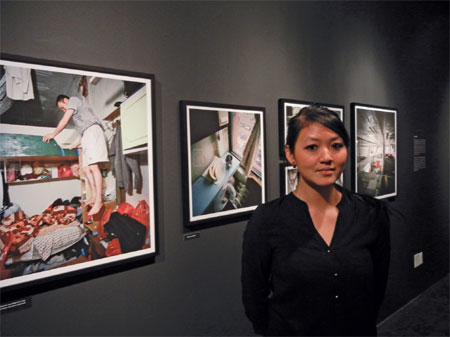Owning Chinatown's stories
Updated: 2013-12-13 12:02
By Kelly Chung Dawson in New York (China Daily USA)
|
||||||||
|
Annie Ling poses with her photographs, featured in "Chinatown: Beyond the Streets," a dual-exhibition at the Museum of Chinese in America that also showcases work by the artist Tomie Arai. Kelly Chung Dawson / China Daily |
In 2008, Taiwan-born photographer Annie Ling was living in a Chinatown tenement building when a late-night fire took everything she owned.
Before bed that night, she had thought to herself that it was time she finally knocked on the doors of her neighbors, who remained mysterious despite their close quarters. They stood outside later while the fire consumed the building, covered in ash and sick with the shared horror of watching their homes disappear.
"That fire was a provocative event, a game-changer that opened my eyes to how precious Chinatown is, and how at risk it is for being lost," Ling told China Daily at the opening of "A Floating Population," an exhibition at New York's Museum of Chinese in America (MOCA) featuring her photographs of Chinatown residents and residences. "Since then, I've documented what I could, with a feeling that in some weird, frenetic way, I am running against time as parts of the neighborhood disappear."
Chinatown's tenements are run-down and often dangerous. As with many other New York neighborhoods, gentrification poses a threat, and as ethnic diversity increases the neighborhood has undergone major changes that beg documentation.
Also featured in MOCA's dual-presentation, "Chinatown: Beyond the Streets," is a new exhibition of art and photographs by Tomie Arai, titled "Portraits of New York Chinatown" and inspired by interviews with 27 Chinatown residents over four years. Featuring screen printing, photography, collages, art and personal artifacts provided by her subjects, the show attempts to demonstrate how a space can be defined by the memories of those who have inhabited it.
"There is a process of social recall, in that the way we remember places and events often have to do with the environment in which we experienced them, in which we embed our memories," Arai said. "When those places disappear, our relationship to those events can change, and my hope is that the show might jar something in those who visit, to think about the way objects contribute to our collective memory of a space."
Arai's work is a "faux or alternative historical record," writes Lena Sze in the exhibition's accompanying catalogue. Although some of the pieces feature straight-forward portraits of her subjects, most of the work instead evokes the view or memories of a person as an equally valid portrait.
In contrast is Ling's work, which presents Chinatown with a journalistic approach that has often exposed the photographer to uncomfortable situations, said Herb Tam, curator and director of exhibitions at MOCA. The neighborhood is notoriously impenetrable, with many residents reluctant to go on the record about their circumstances. But Ling's persistence in spending time with her subjects has given her the access necessary to do her work, he said.
Arai, who is Japanese, has also faced difficulty gaining the trust of her subjects, she said.
"When it comes down to it, your story is the only thing you own," she said. "How your story is told and how you are portrayed is something that people of any culture are fiercely protective of. Chinatown's inaccessibility is also why so much misinformation about the community exists."
In her interviews with residents, Arai found that most accept that the neighborhood will continue to change, but are also invested in the shape that change will take, she said.
"There is a lot of concern about the future of the community, and it's not just nostalgia - there is a sense that is one of the last historic ethnic enclaves in New York, and it's being threatened by displacement," she said. "That leads me to think, 'What is it about the community that makes it so important to preserve?' It's important that we continue to ask that question."
kdawson@chinadailyusa.com
(China Daily USA 12/13/2013 page11)

 After the storm
After the storm
 Mandela's body transferred to Qunu village
Mandela's body transferred to Qunu village
 Illustration: Chang'e-3 soft-lands on moon
Illustration: Chang'e-3 soft-lands on moon
 Guangzhou beats Al-Ahly 2-0 at Club World Cup
Guangzhou beats Al-Ahly 2-0 at Club World Cup
 Two students wounded in US school shooting
Two students wounded in US school shooting
 21 died in Xinjiang coal mine explosion
21 died in Xinjiang coal mine explosion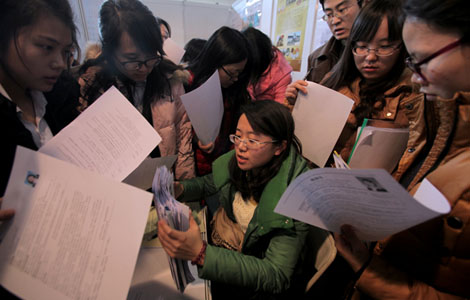
 Postgraduates get hard lessons at job fair
Postgraduates get hard lessons at job fair
 Lippi confident with Guangzhou's opener
Lippi confident with Guangzhou's opener
Most Viewed
Editor's Picks

|
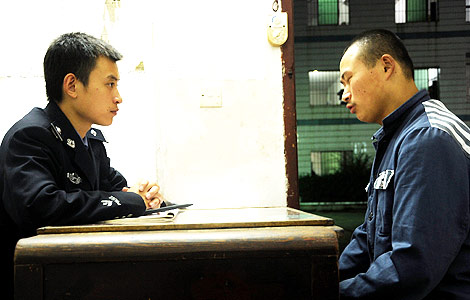
|
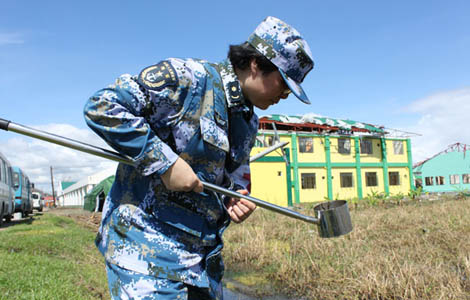
|
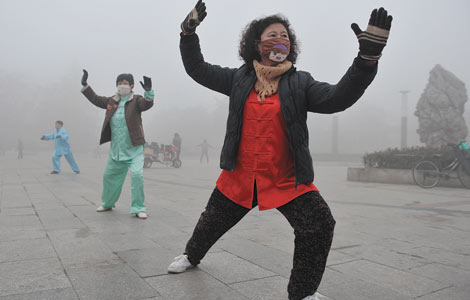
|

|
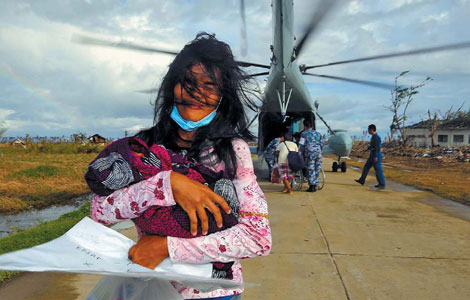
|
Today's Top News
China's 'Jade Rabbit' rolls to moon surface
Statement singles out China's ADIZ
US paves way for in-flight cell phones
Urbanization plan outlined
ASEAN cautious on air zone debate
Leaders vow to steer steady path
BYD dismisses 'inaccurate and misleading' reports
Execution may hit co-op projects
US Weekly

|

|
